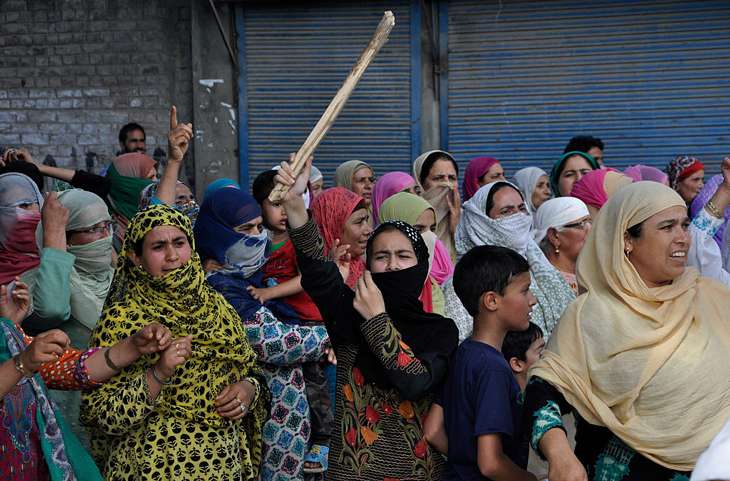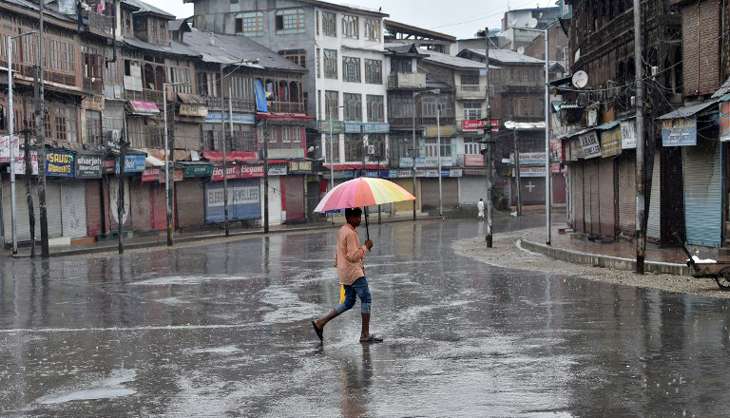As unrest enters 50th day, here's a snapshot of a typical day in curfewed Kashmir

Every morning, when muezzins call for the dawn prayers, a trickle of men in parts of Srinagar gingerly leave their houses - not necessarily for the mosque but to the nearest markets, preferably to the shops located in the mohallas to buy daily essentials like milk, bread, vegetables. Soon, the scene is full of bustle and activity. For a while, a loud, cheerful chatter resounds through the street, almost creating a perception of normalcy.
But as the clock ticks through the wee hours, the anxiety grows. Both shoppers and shopkeepers rush through their transactions. Soon shutters come down, people quickly retrace their steps and the vehicles, if any, speed away. The Hurriyat's protest roster, which calls for endless shutdowns and protests, comes into force. The roads go empty. Shops close. And the residential neighbourhoods go eerily quiet.
Also Read: Kashmir unrest: how RSS ideology blinds Modi govt to the reality
But this is not how it stays. The silent city soon transforms into a stage for an unrelenting contest for control between government forces and protesters. The police and the paramilitary personnel arrive to take over the deserted roads, entry and exit points to many "sensitive" localities are sealed, and barbed wires strung across major road intersections. Neighbourhoods like Dalgate, Hazratbal, Hawal, Nowhatta, Eidgah and Habba Kadal have been under complete lockdown the past 50 days.

But this hardly stops the knots of youth in many parts from hitting the roads, shout anti-India slogans and pelt stones at the security personnel. The battle lasts through the day. The forces respond by firing a gamut of weapons from tear gas canisters through pellet guns to bullets, leading to injuries, blindings and, frequently, to killings, which now number 68. And this is a scene that is replicated all over the valley, more intensely in the countryside than in urban centres, unlike during the three successive summer agitations until 2010.
On the boil
The current uprising began when government forces killed the popular Hizbul Mujahideen commander Burhan Wani on 8 July at Bamdoora village in South Kashmir. As the news of his death spread, thousands of people poured out on to the roads, clogging even the village lanes, to protest and mourn. In the 48 hours following Burhan's death, at least 35 people lost their lives and several hundred were hit by pellets in the eyes, scores of whom have partially or permanently lost eyesight.
It was then that the unrest quickly spread across south Kashmir and from there to central and north Kashmir. Contrary to Mehbooba Mufti's claim that only 5% people are involved in the protests, it feels that the entire population will hit the streets any moment. It is only the unprecedented lockdown and a communication blockade that seems to be keeping an all-out revolt in check.
Fifty days into the unrest and uninterrupted curfew, the situation has changed but little, staying perilously close to a descent into chaos.
Also Read: Kashmir: Invoking Vajpayee won't cut it anymore, Mr Modi. You must act
Across the valley, reports of scores of small and large protests pour in daily into local newspaper offices: demonstrations by men, processions by women, protests on buses and trucks, bike protests and, on some days, protests on boats in the Jhelum river. Videos of these incidents duly land on social media but they don't go viral due to the continuing internet blockade. Many such demonstrations take place deep into the interiors of localities, to avoid the security deployment on the roads. Still, clashes often break out, causing a spike in the mortifying toll of injuries, which latest estimates put at around 10,000, several thousand of them security personnel.

The unprecedented number of injuries, most from pellets, has overwhelmed medical facilities with tertiary care hospitals such as SMHS Srinagar bearing the brunt. The hospital, according to a report submitted by the government to the J&K High Court, has admitted 446 pellet-injured eye patients in 42 days, in addition to several thousand other injured, one of whom succumbs every few days. All eye patients have been operated upon and around 200 of them have lost vision in one or both eyes; the prognosis for the rest isn't much encouraging.
"Eye is a water ball. Once hit by the spinning metal balls of pellets at high speed, it can't be the same again," said an ophthalmologist at SMHS. "The loss of sight, however, could be of varying degrees depending on the nature of the injury."
Chorus for Azadi
As the day winds down, the protests only grow in intensity. The only sound that can be heard across much of Srinagar is a chorus of slogans for Azadi - Hum kya chahte? Azadi! (What do we want? Freedom!); Cheen ke lenge Azadi (We will snatch it - Azadi!), Aaye AayeAzadi (It's coming, Azadi!); Pakistan Zindabad (Long live Pakistan!).
No, the current strife doesn't originate from any specific pockets. But every day, a new set of areas are plunged into the turmoil, and then more. Some of these areas, like Rawalpora in Srinagar, have been largely quiet through the previous agitations and have also seen lesser militancy.

By the time evening falls, the protests abate in many areas, in keeping with the Hurriyat calendar, which offers relaxation in hartal from 6 pm to 6 am. But in many pockets, the protesters don't follow the schedule and continue protesting, even barring traders from opening shops. And as evening gives way to night, the mosque loudspeakers reverberate with Azadi slogans and recorded songs calling for resistance against India. It generally goes on until 10 pm when hush descends on Srinagar and the rest of the valley, even though some parts remain troubled. People retire for the night only to replicate the routine the following day. This is the new normal.
Along the way, the toll of killings and injuries only keeps rising. On Friday, one more youth, Shakeel Ahmad Ganaie, was shot dead during a protest at Haal village in Pulwama. Twenty others were injured, many of them rushed to SMHS in Srinagar. The death toll is now 69.
One of the valley's cynical pastimes these days is counting the dead and the injured and feel resigned to it. Nobody has a clue when it will stop. The struggle for Azadi has become the wait for Godot. Nobody believes it will ever come but everybody hopes it will.
Also Read: Sense of insecurity: why a spate of proposed yatras has Kashmir on edge
First published: 27 August 2016, 0:09 IST




![BJP's Kapil Mishra recreates Shankar Mahadevan’s ‘Breathless’ song to highlight Delhi pollution [WATCH] BJP's Kapil Mishra recreates Shankar Mahadevan’s ‘Breathless’ song to highlight Delhi pollution [WATCH]](https://images.catchnews.com/upload/2022/11/03/kapil-mishra_240884_300x172.png)

![Anupam Kher shares pictures of his toned body on 67th birthday [MUST SEE] Anupam Kher shares pictures of his toned body on 67th birthday [MUST SEE]](https://images.catchnews.com/upload/2022/03/07/Anupam_kher_231145_300x172.jpg)






